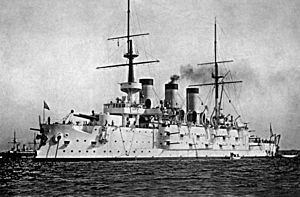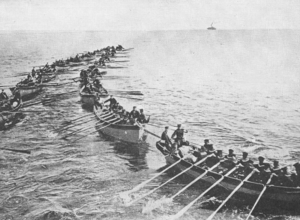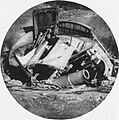Siege of Tsingtao facts for kids
Quick facts for kids Siege of Tsingtao |
|||||||||
|---|---|---|---|---|---|---|---|---|---|
| Part of the Asian and Pacific theatre of World War I | |||||||||
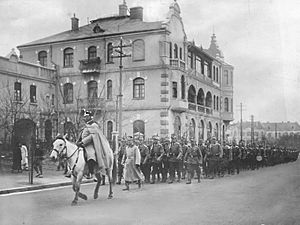 German forces during the siege, November 1914 |
|||||||||
|
|||||||||
| Belligerents | |||||||||
|
|||||||||
| Commanders and leaders | |||||||||
| Strength | |||||||||
|
|
||||||||
| Casualties and losses | |||||||||
|
|
||||||||
| 98 Chinese civilians killed and 30 wounded by Japanese forces | |||||||||
The Siege of Tsingtao was a major battle during World War I. It happened between August 27 and November 7, 1914. This battle was an attack by Japan and the United Kingdom on the German-controlled port city of Tsingtao (now Qingdao, China).
It was the first time Japanese and German forces fought each other. It was also the first time British and Japanese forces worked together in the war. This siege was the only big land battle in the Asian and Pacific part of World War I.
Contents
Why the Siege Happened
Germany's Presence in China
In the late 1800s and early 1900s, many European countries, including Germany, wanted to gain control of lands around the world. Germany started to get involved in China's local matters. After two German missionaries were killed in 1897, China was forced to lease the Jiaozhou Bay Leased Territory to Germany for 99 years.
Germany then built the city and port of Tsingtao. This port became a key base for the German Navy's ships in the Pacific. Britain, also a powerful country, was worried about Germany's growing influence in China. So, Britain leased its own naval port nearby. Other countries like Russia and France also leased areas in China.
Alliances and War Begins
Britain and Japan became close allies, signing the Anglo-Japanese Alliance in 1902. Japan saw this alliance as a way to protect itself from its rival, Russia. Japan showed its strength by winning the 1904–1905 Russo-Japanese War. This alliance continued into World War I.
When World War I started in Europe in August 1914, Britain asked Japan for help. On August 15, Japan told Germany to remove its warships from Chinese and Japanese waters. Japan also demanded that Germany hand over control of Tsingtao. Germany did not agree. So, on August 23, Japan declared war on Germany.
At the start of the war, Germany's East Asia Squadron was spread out across the Pacific. These ships later gathered and then split up. One ship, SMS Emden, went to the Indian Ocean. The rest of the squadron sailed to South America. They won a battle against two British ships, but then the German squadron was destroyed in another battle in the South Atlantic.
Tsingtao's Defenses
Germany had prepared Tsingtao for a possible attack. The city and port were protected by steep hills. The main defense line was along three hills: Mount Moltke, Mount Bismarck, and Mount Iltis. These hills had strong forts with large guns. Fort Bismarck had the biggest guns, four 11-inch howitzers.
A second defense line was set up closer to the city. The final defense line was on hills even closer to the town. Trenches, batteries (groups of guns), and other strongholds were built. Germany also protected the harbor by placing mines in the water. They built four batteries and five redoubts (small forts) along the coast. The defenses were well-equipped, though some guns were older Chinese ones.
Getting Ready for Battle
On August 27, 1914, the Imperial Japanese Navy (IJN) sent ships to block off the coast of Kiaochow. Vice-Admiral Sadakichi Kato led this fleet from his ship, the Suwo. The British Royal Navy (RN) sent two ships to help: the HMS Triumph and the destroyer HMS Usk. On October 14, the Triumph was slightly damaged by German shore guns.
The blockading fleet mostly had older warships. But sometimes, modern ships joined them. These included the powerful battleships Kawachi and Settsu, the battlecruisers Kongō and Hiei, and the seaplane carrier Wakamiya. The Wakamiya's airplanes were the first in the world to attack targets on both sea and land. These Japanese planes also made history with the first night-time bombing raid.
Japanese and British Land Forces
The main Japanese army force was the 18th Infantry Division. It had about 23,000 soldiers and 142 artillery guns. They started landing on September 2 at Lungkow, which was flooded. Later, on September 18, they landed at Lau Schan Bay, about 29 kilometers (18 miles) east of Tsingtao. China protested that Japan was breaking its neutrality, but China did not stop the operations.
The British government was worried about Japan's plans in the area. So, they sent a small group of 1,500 soldiers from Tientsin. This group was led by Brigadier-General Nathaniel Walter Barnardiston. It included 1,000 soldiers from the 2nd Battalion, The South Wales Borderers, and later 500 soldiers from the 36th Sikhs. After an accident where British troops were mistaken for Germans, they were given Japanese raincoats to wear so they could be easily identified.
German Defenders
The Germans brought all their available troops in East Asia to Tsingtao. Kaiser Wilhelm II said that losing Tsingtao to the Japanese would be more shameful than losing Berlin to the Russians. The German forces were led by Captain and Governor Alfred Meyer-Waldeck. They had about 3,625 men. This included marines, navy personnel, Chinese colonial troops, and Austro-Hungarian sailors.
The Germans also had a few ships: the torpedo boat S90, the old cruiser Cormoran, an auxiliary cruiser, four small gunboats, and the Austro-Hungarian cruiser Kaiserin Elisabeth. The crew of the Kaiserin Elisabeth was split, with some fighting on land.
On August 22, a British ship, HMS Kennet, was damaged by the German torpedo boat S90 and shore guns near Tsingtao.
The Siege Begins
As the Japanese got closer, Meyer-Waldeck pulled his forces back to the strongest defense line, closer to the city. The Austro-Hungarian cruiser Kaiserin Elisabeth was in Tsingtao at the start of the war. On September 2, 1914, the German gunboat Jaguar sank the Japanese destroyer Japanese destroyer Shirotae, which had run aground.
On September 5, a Japanese plane scouted the port and reported that the main German fleet had left. The Japanese then ordered some of their big battleships and cruisers to leave the blockade. The next day, the second air-sea battle in history happened. A seaplane from the Wakamiya attacked the Kaiserin Elisabeth and the Jaguar with bombs, but did not hit them.
Later, the Kaiserin Elisabeth's guns were removed and set up on land to form the "Batterie Elisabeth." The ship's crew then joined the land defense. On September 13, Japanese land forces attacked a German rear guard. The Germans retreated, and the Japanese took control of Jiaozhou City and the Santung railway.
Pushing Forward
On September 26, the Japanese army continued its advance. The Germans were forced to retreat beyond the Litsun river. The Japanese moved quickly, crossing the Paisha river and reaching the Litsun river.
On September 27, the Japanese tried to attack Prince Heinrich Hill directly. They were caught in heavy crossfire from German machine guns. The Kaiserin Elisabeth and another German ship also fired on the Japanese, almost making them retreat. But the allied fleet saved the Japanese attack.
As the siege continued, the German ships trapped in the harbor, Cormoran, Iltis, and Luchs, were sunk by their own crews on September 28 so the enemy could not capture them. On October 17, the torpedo boat S90 sneaked out of Tsingtao harbor. It fired a torpedo that sank the Japanese cruiser Takachiho, killing 271 Japanese sailors. The S90 could not get back to Tsingtao and was sunk by its crew in Chinese waters when it ran out of fuel. Other German ships were also sunk by their crews: Tiger on October 29, Kaiserin Elisabeth on November 2, and finally Jaguar on November 7. This was the same day the fortress surrendered.
Final Attack
The Japanese started heavily shelling the fort and the city on October 31. They dug long lines of trenches, just like they had done in the siege of Port Arthur years before. Very large 11-inch howitzers on land, along with Japanese naval guns, constantly bombed the German defenses, even at night. The Japanese moved their trenches closer under the cover of their artillery. The bombing lasted for seven days. The Japanese used about 100 siege guns, firing 1,200 shells each. The Germans used their heavy guns to fire back, but they quickly ran out of ammunition. By November 6, they had no more artillery shells, so surrendering was unavoidable.
The German forces only had one airplane, an Etrich Taube, flown by Lieutenant Gunther Plüschow. (Another German plane had crashed earlier.) This plane was used for scouting and for dropping small bombs on the ships blocking the harbor. Plüschow claimed he shot down a Japanese plane with his pistol, which would have been the first air-to-air victory in history. Plüschow flew out of Tsingtao on November 6, carrying the governor's last messages to Berlin.
On the night of November 6, waves of Japanese soldiers attacked the last line of German defenses and took them over. The next morning, the German and Austro-Hungarian forces asked to surrender. The Allies officially took control of the colony on November 16, 1914.
Images for kids
-
British, Indian and Japanese soldiers in Tsingtao, 1914.
-
Soldiers of the 18th division, Imperial Japanese Army occupy an abandoned German trench during the Siege of Tsingtao, 1914
What Happened After
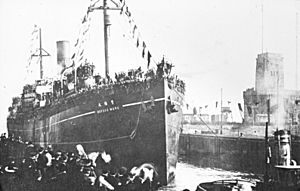
The German forces held out for nearly two months, even though they were blockaded by sea, constantly bombed, and outnumbered 6 to 1. This long defense helped boost their spirits. When the Japanese marched into Tsingtao, the German defenders watched them with interest. But when the British entered, some German officers were so angry they spat at them.
Japanese forces had 733 killed and 1,282 wounded. The British had 12 killed and 53 wounded. The German defenders lost 199 dead and 504 wounded. The German dead were buried in Tsingtao. The remaining soldiers were sent to prisoner of war camps in Japan. During the march to Tsingtao and the siege, Japanese forces killed 98 Chinese civilians and wounded 30.
The 4,700 German prisoners were treated well in Japan, for example, at the Bandō prisoner-of-war camp. They stayed in Japan until the peace treaty was signed in 1919. However, because of some paperwork issues, they did not return home until 1920. About 170 prisoners chose to stay in Japan after the war ended.
See also
- Japan during World War I
- U-boat campaign


